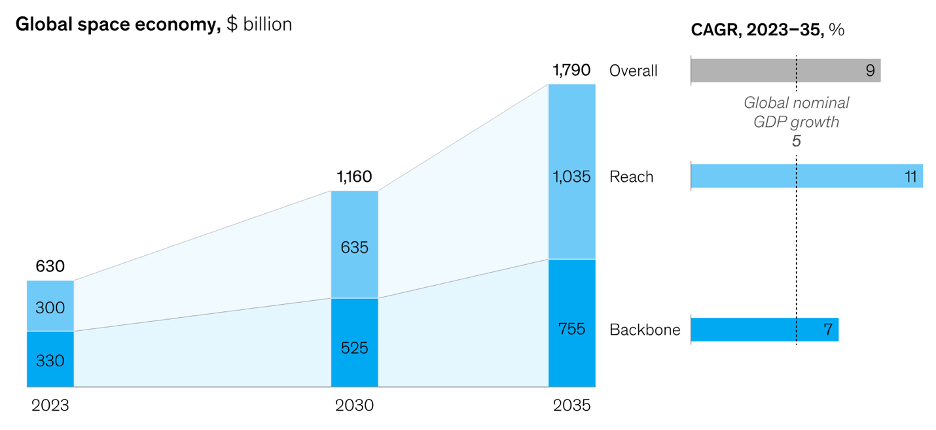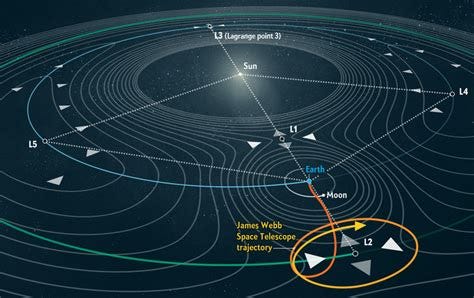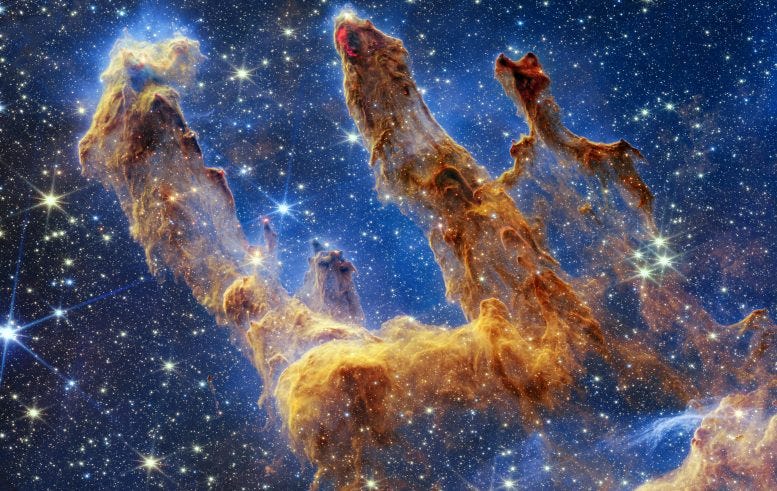Buzz Aldrin described the surface of the moon as “magnificent desolation” when he walked upon it in July 1969. He was referring to the stark beauty of the moon’s surface in the absence of features we see on earth such as vegetation, structures, and other humans. Emptiness can be beautiful.
If the surface of the moon was desolate, the trip there was downright void. The distance between the earth and the moon, 238,855 long empty miles, is devoid of the very same features we see on earth and whose absence makes us think of desolation.
For now, that is.
In low earth orbit (LEO) we’ve already made a mess of things. As of May 2025, there are roughly 11,700 active satellites in orbit, but the number of total satellites (inclusive of those that are no longer operational) could be around 14,900. Add to that the debris fields, discarded rocket bodies, and general space junk flying around our planet, LEO is becoming a proper mess. Conversations are underway about how to clean up space debris and international efforts are discussing how to minimize space debris in the future.
But that’s just for earth orbit.
The space debris problem will extend beyond LEO and threatens to junk up our future path to the moon. Sending spacecraft into cislunar space with any kind of regularity will require infrastructure like NASA’s LunaNet creating the real potential for a buildup of debris beyond our orbit. Cislunar space is the next frontier for the commercial space industry with many companies innovating to put structures and people on the moon. Desolation no more.
Space debris is a danger to humans and equipment and is a big enough problem in LEO. In cislunar, the problem gets significantly worse. As we push back to the moon and beyond, the mitigation of space debris in cislunar space should be a prerequisite, not an afterthought. We have an opportunity to preempt mistakes that we’ve already made in LEO and preserve our ability to travel to the moon and beyond. But we need to understand the problem.
Way Out There
Most are accustomed to how space debris gets there. Dead satellites, old rocket stages, pieces of satellites shot down from the earth, the usual. But how would we get debris hanging around between the earth and the moon? Infrastructure.
The commercial space industry has ambitions of flights beyond earth orbit. The Artemis program is NASA’s program to launch a crewed mission to the moon. Listed on its website under “Why We’re Going to the Moon” is “Economic Opportunity.” With a compound annual growth rate (CAGR) of 35% and a projection of $1.8 trillion in market valuation by 2035, a lot of people stand to make an awful lot of money in space. But it won’t all be in LEO.
LEO is already crowded, both literally and in an economic sense. Further growth will take place in cislunar and interplanetary space. To realize this growth, crewed and uncrewed craft need to be able to safely make it to the moon and back. Doing so will require some amount of infrastructure.
Infrastructure that enables the safe transit from the earth to the moon and back on a regular basis will need to cover a range of functions:
Communication
Position, Navigation, and Timing (PNT)
Repair
Human Health
Supplies
Habitation
More
Not all of this will happen at once, but communications and PNT will be first. There are already plans underway to do this in the form of LunaNet. LunaNet will have physical infrastructure like satellites around the moon to provide communications relays and PNT services. For those satellites to get there, craft will need to be launched to put them there. The same will be true for future cislunar infrastructure and that assumes that everyone plays nicely.
Multiple Players
The value of the space economy is not an American secret. Other spacefaring nations will strive to move into the domain to seek dominance and economic opportunities. A huge question facing the world is whether cislunar infrastructure will be common use or if individual countries will build their own infrastructure. This is what’s already happened on earth for PNT:
EU = Galileo
US = GPS
Russia = GLONASS
China = Beidou
That’s a lot of hardware and a lot of potential for junk and that’s a single use case. There are also clear opportunities for junk in the event of accidents, caches, discarded components, and much more.
The more we build, the more junk we are going to produce. Junk in space does not just go away. We will live with it for possibly thousands of years. The choices we make today will determine whether evidence of our choices will endure.
Celestial Lines of Communication
You’ve heard of sea lines of communication. Well, maybe you haven’t. Either way, the term refers to specific shipping lanes that are strategically important and should be guarded by navies for the safe passage of goods. In space, celestial lines of communication are the same concept applied to the space domain. There are orbital positions that are more strategically important than others such as an orbit that is near a highly valuable satellite. The prepositioning of orbital weapons by Russian forces demonstrates the value of controlling CLOCs.
More missions into cislunar space and the use of cislunar infrastructure will define new CLOCs. There are optimal routes between the earth and the moon that take advantage of gravitational assistance to minimize fuel expenditure. Those trajectories and launch windows could be deemed unsafe by cislunar debris. If launch windows or specific trajectories become unavailable, the space industry will be harmed, and governments will need to come up with ways to respond. Will the temporary denial of launch or return capabilities require a government response? If so, what kind of response? The policy community is not ready to answer these questions yet. Before they attempt to answer it, they need to understand the science.
Not Netflix
The chief scientific problem with debris in cislunar is the circular restricted three body problem (CR3BP). A study from researchers at Johns Hopkins University specifically looked at the CR3BP related to space debris in late 2024.
In space, large objects like the moon and planets create significant gravitational force. If smaller objects venture too close, they come under the gravitational influence of the large object and may fall into orbit, like the moon around earth and the earth around the sun. That is the two body problem, one large object a second smaller object. In cislunar space, however, there are two large bodies to consider, and the addition of a spacecraft or piece of debris makes this a three-body problem. Some terms:
Primary Body (M1): The largest and most massive object (the Earth).
Secondary Body (M2): The second largest and most massive object (the Moon).
Third Body (m3): This is our "restricted" body – it's so small that its own gravitational influence on M1 and M2 is negligible. Think of it as a piece of space debris, a small satellite, or even a future space station.
Circular: This is a key simplifying assumption. We assume that the two primary bodies (M1 and M2) are orbiting each other in perfectly circular paths. Orbits are often elliptical, but for many scenarios, the circular approximation is remarkably good and makes the math much more manageable.
Restricted: This refers to our little third body (m3). Because it's so small, it doesn't affect the orbits of M1 and M2. This simplifies the problem immensely.
In a three-body system, the prediction of how m3 will move relative to M1 and M2 is much more complex than in a two-body problem. Predicting the position and trajectory of a piece of space debris is highly sensitive to its initial conditions; where it is and the trajectory it was on when it became debris. Specifically, we would need:
Taking the initial position and velocity.
Calculating the acceleration at that instant.
Predicting a very small step forward in time.
Recalculating acceleration at the new position.
Repeating this process millions of times to propagate the trajectory over hours, days, or even years.
Add to that perturbation conditions such as solar gravity, solar radiation pressure, and non-spherical gravity and the mathematics of how this tiny piece of debris will move through cislunar space. It is not technically unpredictable but specific initial conditions are needed to predict whether an individual piece of debris will fall toward earth, the moon, or even the sun. Now, multiply that number by the number of pieces of space debris we’ve accumulated in LEO. The problem quickly gets unmanageable.
A Shack Outside Lagrange
In the three-body problem, there are specific locations in cislunar space where the gravitational forces of M1 and M2 plus the centrifugal force from the total rotating system zero out. Basically, it’s a gravity oasis.
From the image above, you can see there are 5 such places in our earth-moon-sun three body system. L1, L2, and L3 are colinear and are unstable. This means that any object that is placed there, or wanders there, will not stay there without a powered effort to keep it there (station keeping). The James Webb Space Telescope sits at L2 where it has a wonderfully unobstructed view of deep space.
L4 and L5 above are stable meaning that objects that are placed there tend to stay there. It is possible that space debris could congregate there the way you see debris in an overflowing river pile up in a specific location. Without management, cislunar debris could become much more dangerous and unpredictable than orbital debris because we don’t know where it will go and how long it will stay there. We can hardly expect to create a system that catalogs the initial conditions for each piece of debris we create and conducts the proper calculations each time a perturbation occurs. The best bet is to not get ourselves into this mess to begin with. That starts now.
No Littering
Junking up our orbital space was entirely predictable from a scientific standpoint, but the international treaties and norms of behavior did not take that into account. When satellites were shot by Russia and China, the debris did not fall. The International Space Station has had to maneuver 39 times to avoid collisions with space debris as of November 2024. Because orbital debris conforms to the two-body problem, debris is more predictable even if it is still a danger. Imagine how much more dangerous debris will become when we aren’t sure where it is or where it is going. Settling into L4 or L5 might end up being the best we can hope for.
The space policy community has taken far too long to recognize and action this problem. Policy makers often wait until something has already taken place before policies get written but that will not work in the case of cislunar debris. Missions are already planned to the moon and plans for supporting infrastructure are live. There are even plans for a solar system internet to enable travel beyond cislunar space.
If anyone building or planning space infrastructure is under the impression they can do it without creating debris, I’d point them to literally all of human history.
Humans aren’t great at building things without some number of leftovers that wait for the next person and the next person to remove and clean. We’ve gotten better, but building in space is another world entirely.
Economic opportunity will drive us into cislunar space and safety will drive us to build infrastructure. Infrastructure will cause debris and debris will cause danger.
A new Outer Space Treaty has been on the wish list of many international space policy professionals for decades. The time is likely not right geopolitically, but if a problem is big enough, things can move. Debris in cislunar space is such a problem. This is the kind of issue that can serve as a centerpiece of future policy action.
Many such actions are required in space and someone needs to lead.






